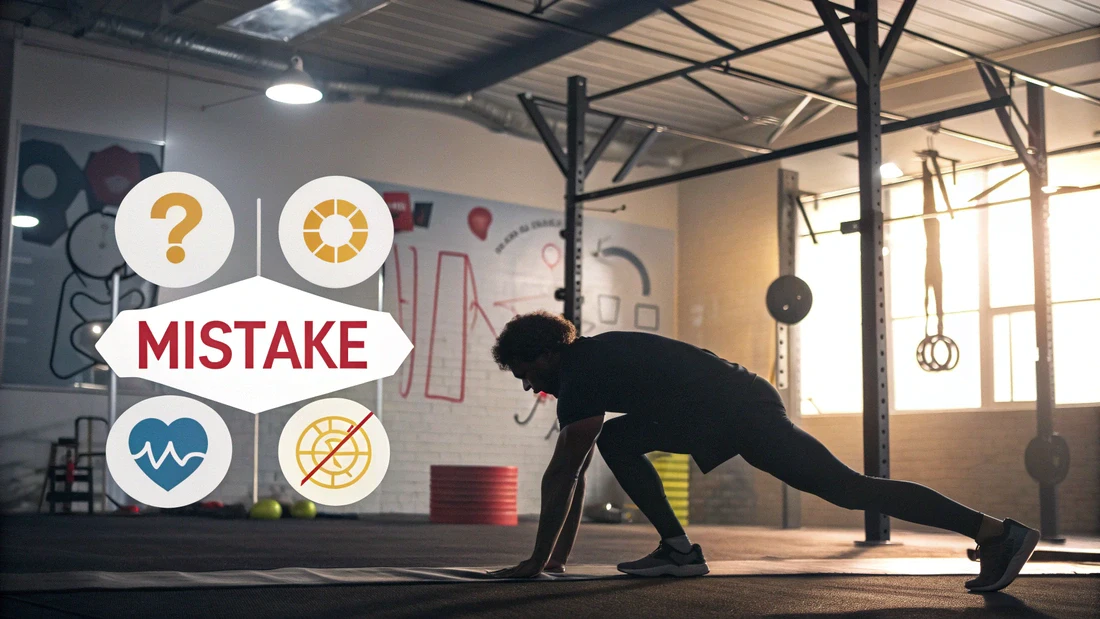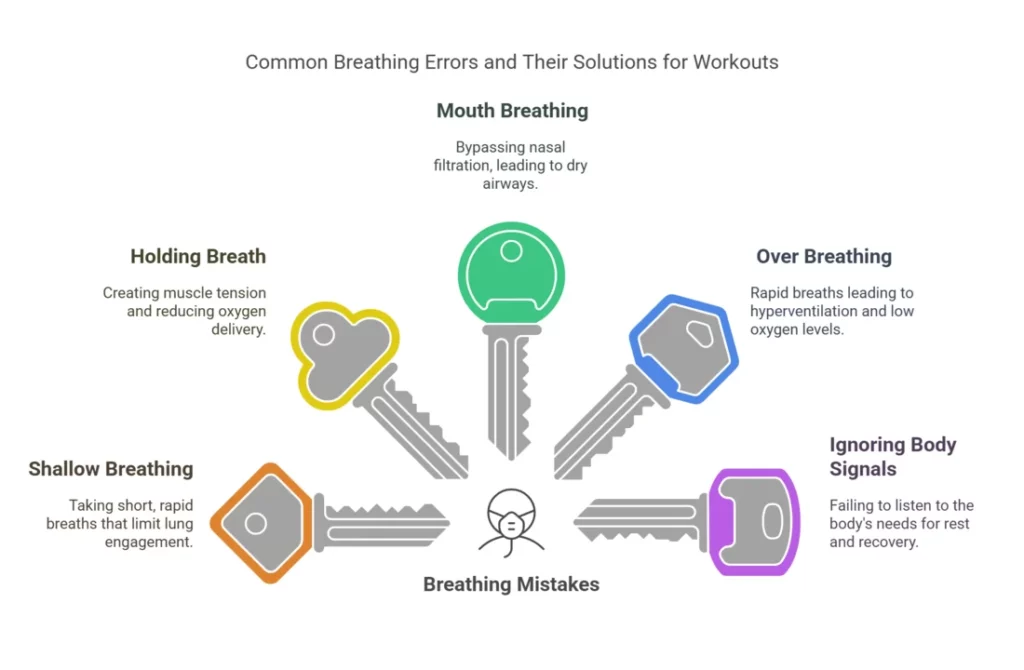Are you putting in the effort during your workouts, but still feel like you’re not making the progress you desire?
You might be surprised to learn that you could be making some common breathing mistakes during workouts without even realizing it.

Many people overlook their breath when they are exercising, and yet it is one of the most powerful tools you can use to enhance your overall performance, and to also make your workouts more effective.
In this post, we’ll identify five of the most frequent breathing errors, and more importantly, show you exactly how to fix them.
Get ready to take control of your breath, and to unlock new levels of fitness!
Why Proper Breathing is Key to a Successful Workout
Before we dive into the common mistakes people make during workouts, let’s take a moment to understand why proper breathing is so essential for a successful workout.
Breathing is not just an unconscious process; it’s a fundamental aspect of human movement that can be harnessed to significantly enhance your fitness journey.
The way you breathe is just as important as the workout itself!

Key Points
- Link Between Breathing and Performance:
- Proper breathing is essential to deliver an adequate supply of oxygen to your muscles, which is necessary for optimal muscle function and efficient energy levels. Breathing and working out go hand in hand, and the more you focus on the former, the more you will benefit from the latter.
- The way you breathe will also have a direct impact on your performance, as it will dictate the amount of power you have, as well as your ability to sustain activity for longer periods of time.
- Negative Impact of Incorrect Breathing:
- When you breathe incorrectly during a workout, you are limiting your body’s ability to provide your muscles with the oxygen they need, which leads to a rapid onset of fatigue. You may also experience shortness of breath, and a decline in overall performance. It is essential to maintain proper breathing to get the most out of any workout.
- Poor breathing can be very detrimental to your ability to workout, and you should avoid these common mistakes at all costs. As time goes on, you may also begin to notice a decline in your stamina and your overall progress.
- Reassurance for Beginners:
- It’s also worth noting that learning to breathe properly during exercise is not as difficult as it may seem. You are definitely not alone if you are feeling overwhelmed, as many people are unsure about how to use their breath. However, with time and practice, you will be able to master this skill and begin to experience all of the many benefits. You just have to start!
5 Common Breathing Mistakes During Workouts
Even if you’re familiar with the importance of breathing, it’s very common to unknowingly make mistakes during workouts.
These errors can limit your overall progress and can also impact how your body is able to perform.
Here are five of the most common breathing mistakes people often make, along with simple ways to fix them.

Key Mistakes and Solutions
Mistake 1: Shallow Breathing
- Explanation: Shallow breathing is when you take short and rapid breaths that don’t fully engage your lungs. This results in limited oxygen intake, which also reduces the removal of carbon dioxide. This is a very common mistake that many people make, without even realizing it.
- How to Fix It: Focus on taking deep, slow breaths, engaging your diaphragm as you inhale. Try to implement methods such as belly breathing, or paced breathing, which will help you to fully utilize your lungs, and to also become more aware of your breathing throughout your workouts.
Mistake 2: Holding Your Breath
- Explanation: Holding your breath, also known as the Valsalva maneuver, is another common mistake that people often make when they are lifting heavy weights, or performing challenging movements. When you hold your breath, you are creating muscle tension, which also reduces oxygen delivery, which will lead to fatigue and poor performance.
- How to Fix It: Become more mindful of your breathing, and take consistent breaths as you are performing your exercises. Try counting your breaths, and focus on the rhythm as you move. This will help you to avoid holding your breath, and also help to improve your overall workout performance.
Mistake 3: Mouth Breathing
- Explanation: Mouth breathing bypasses the important filtration and humidification provided by the nasal passages. This can reduce nitric oxide production and cause a dry mouth and airways, and also a greater risk of infection due to inhaling unfiltered air.
- How to Fix It: Make a conscious effort to breathe through your nose during your workouts. Start slowly, and gradually increase the time spent breathing through your nose. You may find this challenging at first, but with time and patience, this will become your primary method of breathing.
Mistake 4: Over Breathing
- Explanation: Over breathing involves taking short, rapid breaths that can lead to hyperventilation and breathlessness. Although this may make you feel like you are receiving more air, it actually causes the oxygen levels in your bloodstream to drop.
- This often occurs due to tension and stress, which can be improved with breath awareness techniques.
- How to Fix It: Try to focus on taking slow, paced breaths, and ensure that you are not rushing. You should also be focusing on the present moment and to take each breath as it comes. By implementing these changes, you are more likely to create a calm and focused environment for your body.
Mistake 5: Ignoring Your Body
- Explanation: Ignoring your body’s signals can also have detrimental effects on your body and your overall health. It is vital that you are listening to your body and understanding that there may be times where you need to stop, rather than pushing yourself too far.
- It is important to prioritize your overall well-being and understand that recovery is just as important as the workout itself.
- How to Fix It: Be patient with yourself, and understand that everyone is different. You should always listen to your body and do what feels best for you. Try to avoid comparing yourself to others, and focus on the progress that you are making, and your unique journey.
Key Takeaways

To ensure you leave with a clear understanding of all that we have discussed today, here are the key takeaways from this blog post.
By implementing these strategies you are on your way to breathing correctly during your workouts and improving your overall well-being.
- Proper Breathing is Crucial: Remember that proper breathing is just as important as your workouts. You should prioritize your breath, as it is the key to unlocking your overall fitness potential, and will lead to improved performance, endurance, and recovery.
- Identify Common Mistakes: Be aware of the common breathing errors, such as shallow breathing, holding your breath, and mouth breathing, and make an effort to avoid these in your daily routine. By being aware of these common problems, you are in a better position to change them.
- Implement Nasal Breathing: Strive to breathe primarily through your nose during your workouts, to make the most of your body’s natural system, and to improve your performance and wellbeing.
- Use Diaphragmatic Breathing: When you are focusing on your breath, and working to improve your breathing techniques, make sure you are using belly breathing to ensure you are getting the maximum effect from each breath.
- Try Paced Breathing: In addition to belly breathing, it is also important to explore other methods such as paced breathing, which may be more appropriate for some forms of exercise. The key is to be versatile.
- Listen to Your Body: Always listen to your body, and take breaks where needed. Be patient with yourself and be sure you are not pushing yourself too hard, especially when you are first beginning with these methods.
How To Start Implementing These Methods Into Your Routine
It is not enough to simply learn about new techniques; it’s about how you put them into action.
To ensure you start using these methods as effectively as possible, let’s discuss some practical ways to make these changes a part of your everyday life.
Remember that you are in control of your journey, and that you can adapt each of these methods to best suit your needs.
Key Tips
- Practical Advice For Implementation:
- It is best to start small and to slowly integrate these techniques into your workouts. Do not try to overhaul your entire workout routine, as this can feel overwhelming and daunting. Focus on implementing one small change at a time, such as focusing on nasal breathing, or diaphragmatic breathing, and then once you feel more comfortable, you can add more.
- Remember that the key is to make these changes sustainable, and not to force yourself to do anything you are uncomfortable with.
- Guidance on How To Monitor Your Progress:
- To know whether these methods are working for you, it is important to become more aware of your body, and to monitor your progress throughout the process. Ask yourself questions such as: How do I feel after my workouts? Am I struggling with breathlessness? Do I feel more focused?
- You can also choose to write your progress down, and keep track of how long you have been doing these methods for, and also to track any changes to your overall performance.
- Improvement is Not Linear:
- It’s important to understand that improvement is not always linear. There may be days where you feel like you are not getting any better, or where you may revert back to old habits. That is perfectly okay, and you should not get disheartened by these moments. Simply pick yourself up, and try again, as that is the only way you will reach your goals.
- Be patient with yourself, and remember to just continue as you are, and over time you will achieve the results you desire.
Frequently Asked Questions About Breathing Mistakes
To ensure that you are fully equipped to deal with any common breathing problems, let’s explore some of the most frequent questions that people have.
These answers will provide practical and actionable advice, and also allow you to better understand the process of breathing.
- Question 1: Why is it so hard to breathe during exercise?
- Answer: The reason why many people find it hard to breathe during exercise is because their bodies are demanding more oxygen than they are used to providing. This can also be because they are making common breathing mistakes such as breathing too shallow or through their mouth. This can lead to a buildup of carbon dioxide, and will also lead to fatigue. Remember, proper breathing techniques are incredibly important.
- Question 2: How to improve breathing while working out?
- Answer: To improve breathing while working out, focus on implementing techniques such as diaphragmatic breathing, and paced breathing. These methods help to improve your oxygen intake, and they will also help you to conserve energy throughout your workout. It is also important to focus on nasal breathing, as this is the most optimal method for the body.
- Question 3: Should you breathe through your mouth during hard exercise?
- Answer: While mouth breathing may feel like a natural response during high-intensity workouts, it can actually be detrimental to your performance. It is always best to breathe through your nose, as this method helps to warm and filter the air. You should always strive to breathe through your nose, but if you are struggling, and it feels like you need to breathe through your mouth, do so, but always strive to return to nasal breathing where possible.
- Question 4: What is shallow breathing?
- Answer: Shallow breathing is when you take short and rapid breaths that do not fully engage your lungs. This method of breathing limits the amount of oxygen your body receives, and also reduces the removal of carbon dioxide from the body. This is a common mistake and can be improved with consistent practice, and with mindfulness.
Final Thoughts On Common Breathing Mistakes
As we conclude this guide, I hope you now have a much better understanding of the common breathing mistakes that people often make when they are exercising, and also how to avoid them.
This is a skill that takes time to perfect, but with patience and consistent practice, you will be on your way to a better workout journey.
We’ve explored five of the most common breathing errors, including shallow breathing, holding your breath, mouth breathing, over breathing, and ignoring your body.
We have also discussed how to correct each of these, and also how to make sure that your body is performing at its peak.
By being aware of these common mistakes, and also knowing how to correct them, you are on your way to improving your workouts and your overall health and wellbeing.
I encourage you to start implementing these changes today, and to focus on correcting your breathing during your next workout session.
Do not be afraid of making mistakes, as they are a part of the learning process, and with time and patience you will overcome them.
You should also be open to learning new methods of breathing and to explore which techniques work best for you.
Now go forth, and breathe!
References
- Breath Tools: A Synthesis of Evidence-Based Breathing Strategies to Enhance Human Running – Frontiers in Physiology
- Shallow Breathing – ScienceDirect
- Cardiovascular Response to Breath-Holding Explained by Changes of the Indices and their Dynamic Interactions – ResearchGate
Related Posts
No posts
